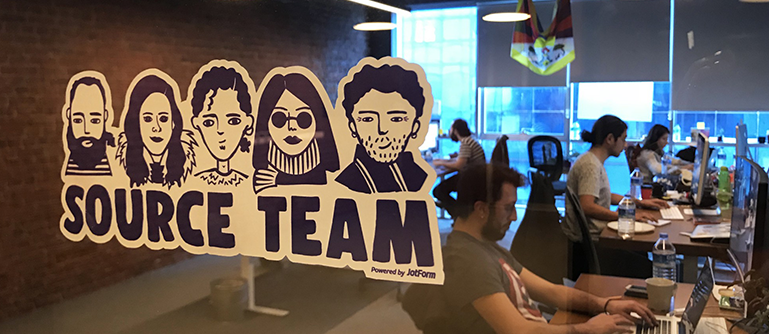- |
- |

As we hurtle headfirst into a new financial year, the August team is focussed on maintaining momentum. Whether you hope to build excitement through a presentation, hand-crafted content or a gamified form, I’ve got an article to help you on stay on track.
This month, I’m sharing eight articles on design, digital and tech to keep velocity high, and productivity steady for the slope ahead.
Welcome to Super8 in June!
1. Seven ways to structure your presentation to keep audiences wanting more.

- Read the full article here.
- Written by Orana Velarde.
- Contributor: Rowan Barnes.
Whether you’re presenting for a conference, client pitch or company meeting, presentations can be a key part of your day-to-day. Presentations aren’t limited to a role type or career rung: it’s important for everyone to convey ideas with clarity and purpose.
No matter how many facts or charts need to be presented, incorporating stories into a presentation will keep your audience focused and intrigued. Using stories to support data is a well-known technique in all aspects of public speaking, from motivational talks to in-company sales pitches.
But presentations aren’t always as simple as the pros make it seem, and we’re often left to hone this skill on our own. In this article, Orana communicates some of the ways you can share your message and keep audiences interested. After reading up on these tips and templates, we’re betting your next presentation will be a success.
2. Why people stop reading before the end of a page.

- Read the full article here.
- Written by Nick Usborne.
- Contributor: Aziza Mohamed.
In this piece, Nick tackles a challenge common to all writers: holding a reader’s attention online. Scratch the surface and you’ll find every page has a purpose, but that purpose is rarely achieved if people don’t read to the end of the content.
In a space where thousands of content publishers compete across every imaginable niche, there’s opportunity to stand out from the crowd when it comes to quality. Bottom line: you’ve got to be quick, clear, consistent and connect with your audience when crafting digital content.
3. How a team made form filling more fun.

- Read the full article here.
- Written by Dilem Akiner.
- Contributor: John Broadfoot.
Forms: the web’s full of them. They’re key in conversion and convey unique information—why, then, do so many lack the flair to make for an awesome experience? Customer surveys don’t need to be boring. In fact, Dilem argues this is where design has the potential to enhance forms like the Likert Slider.
Filling out forms can feel like a boring, obligatory task, but when we watched the user testing videos, it was clear that respondents enjoyed filling out the newly designed Emoji Slider. It encouraged a fun, gamified experience that makes people smile.
Combining emojis, colour, and gamification, learn how the team at JotForm set out to improve their customer experience using a simple input field.
4. Why boredom is so powerful in your life.

- Read the full article here.
- Written by Gustavo Razzetti.
- Contributor: Freya Fajgman.
Gustavo Razzetti opens this article with a question: are you bored or just experiencing boredom? Now, don’t think this is a boring question, the distinction could determine your life satisfaction.
We feel bored because, deep inside ourselves, we know we can give more. Boredom is the pain of unused potential; it’s a disconnection to everything we can offer the world and vice versa.
When we explore the origins of boredom, it’s possible to see its potential as a force for good—instead of another reason to stay busy. Looking at boredom from different perspectives, Gustavo shows us how to turn an idle afternoon into an ally when it comes to creativity and embracing new ideas.
5. You don’t learn anything from design inconsistencies that go unnoticed.

- Read the full article here.
- Written by Fabricio Teixeira.
- Contributor: Melanie Bruning.
It’s often said that we learn far more from our mistakes than our successes—but without the ability to recognise when things go wrong, we lose the opportunity to make things better. As Fabricio Teixeira notes in this article, when no one catches an error, it’s like it never existed in the first place.
This snappy read packs some punch with a salient point: making mistakes—and having them noticed—is essential when developing attention to detail in design.
6. Trust your data: how to efficiently filter spam, bots and other junk traffic in Google Analytics.

- Read full article here.
- Written by Carlos Escalera.
- Contributor: David Baddock.
Can you trust your data? Capturing data is most effective when it’s optimised for accuracy, especially for analysts, marketers or organisations that value data-driven decision-making. The reliability of your data isn’t limited to input or output—it’s a combination of accurate configuration, reputable sources and informed analysis.
Think of a Google Analytics property without filtered data as one of those styrofoam cakes with edible parts. It may seem genuine from the top, and it may even feel right when you cut a slice, but as you go deeper and deeper you find that much of it is artificial.
Moz’s Carlso Escalera helps us put this question to rest when it comes to site analytics. Follow his well-researched guide to ensure your Google Analytics setup is accurate and spam-free.
7. What we’ve learned building a remote culture.

- Read the full article here.
- Written by Nick Francis.
- Contributor: Zoe Warne.
Transitioning to a remote company structure can create new ways of working, because it requires a shift in the way teams collaborate, communicate new processes, and the adoption of an ‘all-in’ attitude. While change takes time, there are many benefits for companies that rise to the challenge.
The most important reason is talent. Think of it this way: Do you think more talent exists within a 20-mile radius of your office, or on planet earth?
Help Scout’s Nick Francis has some excellent advice for those working with, or looking to build, a remote team. Nick covers everything from the common struggles of remote workers to strategies for building remote team culture at your company today.
8. Narcissus vs. Echo: beginning of the end for visual designers.

- Read the full article here.
- Written by Anirban Ghosh.
- Contributor: Daniel Banik.
In this article from Thoughtworks, we explore the Greek tale of Narcissus and Echo to represent a growing shift in digital: the transition from visual to voice. Anirban Ghosh argues that traditional design should make way for multi-disciplinary, multi-sensory designers who can leverage automation to craft experiences for new interfaces.
As Anirban states: designers need to look beyond the captivating screens they create and be aware of the voice technology that’s disrupting businesses and redefining user experiences.
More Articles
Up for some more?
Get your monthly fix of August happenings and our curated Super8 delivered straight to your inbox.
Thanks for signing up.
Stay tuned, the next one isn't far away.
Return to the blog.
